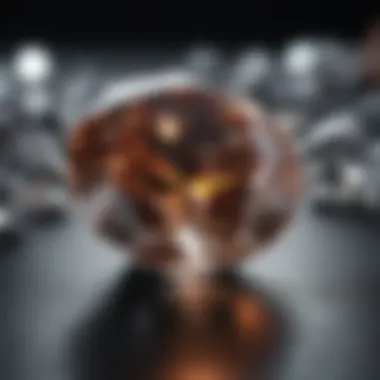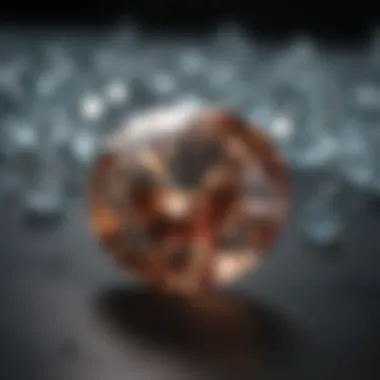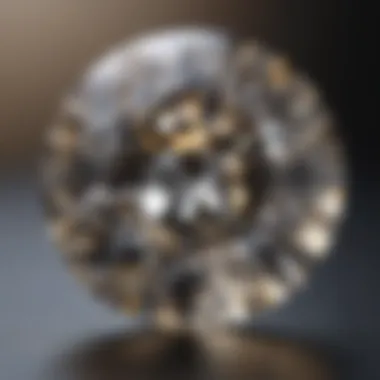Are Factory Diamonds Genuine or Counterfeit? Unveiling the Truth Behind their Creation


Overview of Gemstones and Minerals
Factory diamonds, commonly known as lab-grown or synthetic diamonds, have sparked significant interest in the jewelry industry due to their unique characteristics and manufacturing process. These diamonds are created in controlled laboratory settings rather than mined from the earth, revolutionizing the traditional diamond market. The exploration of factory diamonds unveils a fascinating realm of authenticity and quality, challenging the conventional norms associated with natural diamonds.
Gemstone Formation and Properties
The formation of factory diamonds involves advanced technological processes that replicate the natural conditions under which diamonds are created in the earth's mantle. By utilizing innovative techniques, scientists can accelerate the diamond growth process, resulting in gem-quality stones with remarkable clarity and brilliance. The properties that define factory diamonds include their chemical composition, crystal structure, and optical properties, which closely mirror those of natural diamonds.
Types of Gemstones
In the realm of gemstones, factory diamonds stand out as a distinct category, offering a sustainable and ethically conscious alternative to traditional mining practices. While natural diamonds hold historical significance and cultural symbolism, factory diamonds represent a modern evolution in gemstone production. Their availability in various shapes, sizes, and colors caters to diverse consumer preferences, making them a versatile choice for jewelry designers and gem enthusiasts alike.
Identifying and Evaluating Gemstones
When evaluating factory diamonds, key factors come into play to determine their value and quality. These criteria include carat weight, cut quality, color grade, and clarity grade, which collectively influence the overall appeal and price of the diamond. Gemologists employ specialized techniques such as magnification and spectroscopy to identify and assess the characteristics of factory diamonds accurately, ensuring transparency and authenticity in the marketplace.
Caring for Gemstones
Proper care and maintenance are essential to prolonging the beauty and lifespan of factory diamonds. Cleaning factory diamonds regularly with mild soap and water helps preserve their luster and clarity, while storing them separately from other jewelry prevents scratches and damage. By following expert guidelines and avoiding common mistakes in gemstone care, owners can safeguard the integrity of their factory diamonds for generations to come.
Introduction
In this crucial part of our exploration into the realm of factory diamonds, we unveil the truth behind these stunning creations. Factory diamonds, often a subject of intrigue and debate, hold a significant position in the gemstone industry. Understanding the process of their creation and distinguishing their characteristics from natural diamonds is paramount for enthusiasts and collectors alike. As we embark on this journey, we will delve deep into the intricacies that define the authenticity and allure of factory diamonds. This section serves as the gateway to a world where traditional craftsmanship meets cutting-edge technology, shaping the landscape of fine jewelry design and consumer preferences.
Factory diamonds, also known as lab-grown or synthetic diamonds, have revolutionized the conventional diamond market. Their emergence symbolizes innovation and sustainability, challenging the perception of luxury and exclusivity associated with natural diamonds. By examining the manufacturing techniques and quality assessments of factory diamonds, we unravel a narrative that transcends the boundaries of traditional gemstone procurement. This narrative captivates not only geology enthusiasts and jewelry designers but also eco-conscious consumers seeking ethically sourced alternatives in a dynamic marketplace. By illuminating the distinct properties and advantages of factory diamonds, we empower our readers to make informed decisions amidst evolving industry trends.


The essence of this article lies in demystifying the intricacies of factory diamonds to uncover the essence of their existence. From the high-pressure high-temperature (HPHT) method to chemical vapor deposition (CVD) processes, each facet of diamond production reveals a story of craftsmanship and innovation. By presenting a comprehensive guide to distinguishing between factory and natural diamonds, we shed light on the physical characteristics and chemical compositions that shape their individuality. Through detailed analysis and exploration, we aim to elevate the discourse surrounding factory diamonds, offering a nuanced perspective that resonates with a discerning audience seeking intellectual enrichment in gemstone discourse.
Understanding Factory Diamonds
In the realm of gemstones, comprehending the origins and production methods of factory diamonds holds considerable significance. The meticulous examination of factory diamonds sheds light on their authenticity and characteristics, providing invaluable insights into the intricacies of the gemstone industry. Understanding Factory Diamonds serves as a cornerstone in the exploration of diamond authenticity, offering a nuanced perspective that resonates with gemstone enthusiasts, collectors, and jewelry designers alike.
Manufacturing Process
Diving into the manufacturing processes of factory diamonds unravels a fascinating journey characterized by innovation and precision. Two prominent methods, namely the High-Pressure High-Temperature (HPHT) method and the Chemical Vapor Deposition (CVD) method, stand out for their distinctive approaches to diamond synthesis.
High-Pressure High-Temperature (HPHT) Method
The High-Pressure High-Temperature method represents a pinnacle of technological advancement in diamond creation. By subjecting carbon to extreme pressure and temperature conditions, this method replicates the natural diamond-forming environment within a laboratory setting. The key characteristic of the HPHT method lies in its ability to produce diamonds that exhibit exceptional clarity and hardness, mirroring the attributes of natural diamonds. Despite its efficiency in generating high-quality diamonds, the HPHT method faces drawbacks concerning its energy-intensive nature and limited scalability, factors that warrant deliberation in the context of sustainable gemstone production.
Chemical Vapor Deposition () Method
Conversely, the Chemical Vapor Deposition method offers a versatile and cost-effective alternative for manufacturing diamonds. Through the deposition of carbon-rich gases onto a substrate, this method facilitates the precise growth of diamond crystals with controlled attributes. The distinctive feature of the CVD method lies in its capacity to generate large, high-quality diamonds with customizable characteristics, making it a favored choice in industrial applications. However, challenges related to impurity control and uniformity assurance underscore the ongoing refinement needed to optimize the CVD method's efficiency and output quality.
Quality Assessment
Evaluating the quality facets of factory diamonds involves a meticulous analysis of various parameters to ascertain their worth and performance.
Color and Clarity Grading
Color and clarity grading constitute fundamental criteria for assessing the visual appeal and value of diamonds. The distinct hues and internal reflections present in diamonds determine their aesthetic allure and market desirability. Effective color and clarity grading methodologies not only enhance consumer confidence but also contribute to the transparent valuation of factory diamonds, fostering a culture of integrity and authenticity within the gemstone industry.


Cut Quality Evaluation
The cut quality of a diamond serves as a defining factor in its brilliance and visual allure. The precision and artistry employed in shaping diamond facets directly influence its light reflection properties and overall sparkle. A thorough evaluation of cut quality parameters ensures the optimization of a diamond's optical performance, enriching its beauty and allure for both the wearer and the observer. Adhering to stringent cut quality standards reflects a commitment to excellence and craftsmanship, essential facets in distinguishing factory diamonds of superior quality.
Durability and Longevity
Durability and longevity considerations are vital aspects in assessing the wearability and resilience of factory diamonds. The structural integrity and resistance to external factors such as scratches and breakage determine the longevity of a diamond. By prioritizing durability testing and material quality assurance, manufacturers can guarantee the longevity of factory diamonds, offering consumers a durable and enduring investment in fine jewelry. The balance between hardness and toughness in diamond compositions underpins their durability, highlighting the meticulous craftsmanship and material expertise essential in producing durable and long-lasting jewelry pieces.
Distinguishing Between Factory and Natural Diamonds
Distinguishing between factory-created diamonds and natural diamonds is a critical aspect of this article. By understanding the physical characteristics and chemical composition of these diamonds, readers can discern the authenticity and origins of their gemstones. This section explores the significance of differentiating between these two types of diamonds, shedding light on the complexities involved in gemstone identification. Discerning between factory and natural diamonds involves examining optical properties, inclusions and blemishes, and weight and size variations. Each aspect plays a crucial role in determining the provenance and quality of a diamond, offering insights into its rarity and value proposition. Gemstone enthusiasts and collectors will benefit greatly from this detailed exploration of the distinguishing features of factory and natural diamonds, enabling them to make informed decisions when acquiring gemstones for their collections.
Physical Characteristics
Optical Properties
Optical properties are a fundamental aspect of gemstone evaluation, impacting a diamond's brilliance, fire, and sparkle. The refractive index, dispersion, and luster of a diamond contribute to its visual appeal and rarity. Understanding optical properties allows gemologists and collectors to assess the quality and authenticity of a diamond accurately. The play of light within a diamond, known as its 'fire,' is a unique characteristic that mesmerizes viewers and distinguishes exceptional gemstones. Optical properties serve as a cornerstone for grading diamonds, emphasizing their allure and value in the competitive gemstone market.
Inclusions and Blemishes
Inclusions and blemishes are natural features present in diamonds that affect their clarity and purity. While some inclusions add character and uniqueness to a diamond, others may detract from its visual appeal and value. Analyzing inclusions and blemishes under magnification provides insights into a diamond's formation history and authenticity. Gemologists use these internal features to differentiate between factory-created and natural diamonds, as their presence varies significantly between the two types. Understanding the nature and extent of inclusions and blemishes is essential for gauging a diamond's quality and rarity accurately.
Weight and Size Discrepancies
Weight and size variations in diamonds can indicate the production method and originality of the gemstone. Factory-created diamonds may possess uniformity in weight and size due to controlled manufacturing processes, whereas natural diamonds exhibit variations resulting from geological factors. Evaluating weight and size differences aids in distinguishing between lab-grown and mined diamonds, offering clues about their authenticity and value proposition. Gemstone enthusiasts keen on acquiring unique and rare diamonds value the distinctiveness conferred by natural variations in weight and size, enhancing their collection's exclusivity and allure.


Market Trends and Consumer Insights
The section of Market Trends and Consumer Insights is of paramount importance in this article on factory diamonds as it sheds light on the ever-evolving landscape of the diamond industry. Understanding the current market trends and consumer preferences is crucial for both industry professionals and enthusiasts. By delving into Market Trends and Consumer Insights, readers can grasp the dynamic nature of the diamond market and how it influences the production and consumption of factory diamonds. Analyzing the shift towards lab-grown diamonds and the reasons behind consumer preferences provides valuable insights for gemstone enthusiasts, collectors, and jewelry designers seeking to navigate this changing terrain.
Rise of Lab-Grown Diamonds
Shift in Consumer Preferences
The Shift in Consumer Preferences towards lab-grown diamonds marks a notable transformation in the traditional diamond market. This shift signifies a growing preference among consumers for sustainable, ethically sourced, and cost-effective options. The key characteristic of this shift lies in the conscious decision of consumers to opt for diamonds created in controlled laboratory environments over mined diamonds. The unique feature of this shift is the reduction in environmental impact and the ability to support ethical practices within the industry. However, challenges related to perceived value and market acceptance remain as drawbacks of this consumer preference.
Environmental and Ethical Considerations
The focus on Environmental and Ethical Considerations in the context of lab-grown diamonds is a significant driver shaping the diamond industry. Consumers are increasingly mindful of the ecological footprint and ethical implications of their purchases, leading to a surge in the demand for sustainable alternatives. The key characteristic of this trend is the emphasis on transparency and responsible sourcing practices within the diamond supply chain. The unique feature of these considerations is the ability to align consumer values with their purchasing decisions, fostering a more socially conscious marketplace. While the advantages include reduced environmental harm and ethical sourcing, challenges such as pricing disparities and industry regulations pose potential obstacles.
Perception and Acceptance
Luxury Industry Impact
The Luxury Industry Impact on lab-grown diamonds plays a pivotal role in shaping consumer perceptions and acceptance. Luxury brands and retailers embracing lab-grown diamonds influence market trends and consumer behaviors significantly. The key characteristic of this impact is the integration of lab-grown diamonds into high-end jewelry collections, challenging traditional views on diamond authenticity and value. The unique feature lies in the ability of luxury brands to leverage sustainability and innovation to attract discerning clientele seeking ethical and exclusive pieces. Despite its appeal, concerns regarding exclusivity and brand reputation emerge as potential disadvantages.
Influence on Traditional Diamond Market
The Influence on Traditional Diamond Market by the rise of lab-grown diamonds underscores a paradigm shift in the industry landscape. This influence reflects changing consumer preferences and the competitive pressures faced by natural diamond suppliers. The key characteristic is the reevaluation of supply chains and marketing strategies by traditional diamond players to adapt to the evolving market dynamics. The unique feature here is the potential synergy between lab-grown and natural diamonds, offering consumers diverse choices while reshaping industry standards. However, challenges related to market positioning and consumer education present complexities for both segments.
Conclusion
As we reach the conclusion of this exploration into the realm of factory diamonds, it becomes evident that the significance of this topic extends far beyond mere gem appreciation. The discourse surrounding the authenticity and characteristics of factory diamonds serves as a magnifying glass, scrutinizing the intricate interplay between innovation, tradition, and consumer consciousness within the diamond industry landscape.
One of the key takeaways from this article is the pivotal role that factory diamonds play in redefining the standards of ethical and sustainable practices in gemstone production. By dissecting the nuances of their manufacturing processes and quality evaluations, we are compelled to confront the evolving narrative of what defines a 'real' diamond in a contemporary socio-economic context where environmental impact and ethical provenance hold equal weight alongside intrinsic beauty.
Moreover, the implications of distinguishing between factory and natural diamonds ripple across not only the luxury market but also the collective ethos of consumers worldwide. As discerning gemstone enthusiasts and jewelry aficionados delve deeper into the origins and implications of their precious acquisitions, the lines between authenticity, value, and responsibility blur, ushering in a new era of conscientious consumption.
In essence, the holistic understanding of factory diamonds offered in this article serves as a compass navigating the intricate currents of gemstone provenance and consumer awareness. By bridging the technical intricacies of diamond manufacturing with the broader spectrum of market trends and ethical considerations, we pave the way for a more enlightened and informed dialogue that transcends the mere allure of sparkling gemstones, charting a course towards a more transparent and sustainable future for the diamond industry.







